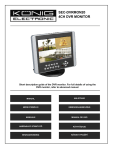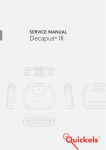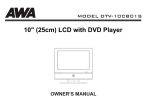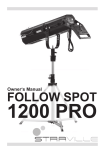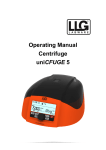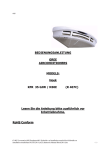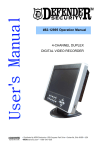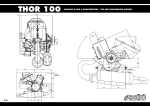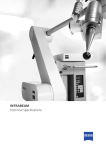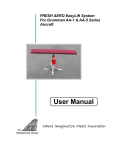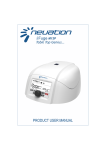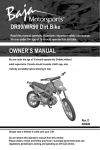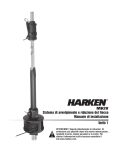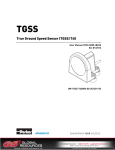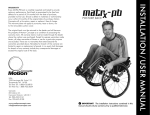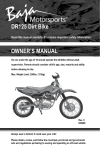Download N2 Nitro Plastic welding system Installation and user manual
Transcript
141216 - Translation N2 Nitro Plastic welding system -1- We are Lascare, specialists in auto body repair tools and equipment. N2 Nitro Plastic welding system Installation and user manual Manual for the installation of your new N2 Nitro plastic welding system and its optimal use in repairing plastic bumpers and other plastic parts. Attention: This device will produce hot air with a maximum temperature of 700°C. Please provide sufficient ventilation in the work area while processing the materials with our equipment. The noise level in the work area is less than 70 dB (A). Safety precautions: Attention! The following safety precautions should be considered while using electric tools, in order to prevent injuries as a result of shock or fire. Read and pay attention to these precautions before using any electric tool. File these safety precautions well! 1) Keep the workplace tidy - An untidy workplace may lead to accidents. 2) Keep the surrounding area in order - Never leave electric tools out in the rain; - Do not use electric tools in damp or wet conditions; - Take care of proper lighting in the work area; - Keep electric tools away from flammable liquids or gas. 3) Prevent electric shocks - Avoid contact with earthened objects, such as metal pipes, radiators, heaters, refrigerators, etc. 4) Keep away from children - All observers shoud be kept at a safe distance from the work area. Do not let any other person touch the tools, cords and/or hoses; 5) Tools should be stored safely - When not in use, tools shoud be kept in a dry and secure location, out of the reach of children. 6) Do not misuse the cord - Never carry a tool by the cord or hose; - Never yank the cord or the hose to disconnect it from the receptacle; - Keep cords and hoses away from heat, oil and sharp edges. 7) Maintain a safe working posture - While operating the equipment be sure to keep good footing and maintain good balance. 141216 - Translation N2 Nitro Plastic welding system 8) Avoid accidental starting - Be sure that the equipment is disconnected during transport; - Be sure that the switch button is turned off before starting the equipment; 9) Extension cords for outdoor use - For outdoor use only approved extension cords, that are marked accordingly, may be used. -2- 10) Be cautious at all times - Be cautious at all times during the procedure. Act wisely and only use the equipment when focused. 11) Check the electric equipment for damages - Before further use of the equipment safety devices and/or damaged parts should be checked for their proper function. Check the proper functioning of moving parts, that no part is broken of jammed, and that all other parts are well assembled and that the equipment can function properly. Unless otherwise indicated in this manual, damaged parts and switches and/or safety devices, should be properly repaired by a specialized service department. Do not use any equipment that cannot be switched on or off properly! 12) Attention For your personal safety: only use accessories and/or materials that are recommended in the manual or catalogue. The use of other accessories and/or materials may cause bodily harm. Introduction • N2 Nitro Plastic welding system Thank you for purchasing the Lascare N2 Nitro Plastic welding system. No other system will enable you to repair plastic parts faster and more profitable. When using our N2 Nitro Plastic welding system the repairs will be of the highest quality – maximum strengt hand minimum disadvantages. Your investment in this equipment is an investment in quality and productivity, giving your company the competitive edge over other repair companies. With the N2 Nitro Plastic welding system you will…… * be able to execute repairs faster, no waiting for ordered parts; * be able to perform high-quality repairs, no sagging caused by the use of 1K welding wire; * be able to perform more cost effective repairs, both for the client and the contractor; * be able to perform repairs none of your competitors can, thus generating more orders; * be able to show contractors and insurance companies that you invested in the latest technology, available in plastic welding. This manual will not only show you the principals of the use of the N2 Nitro Plastic welding system but will also give a number of unique repair techniques. -3- 141216 - Translation N2 Nitro Plastic welding system Installation and use • N2 Nitro Plastic welding system Requirements for the connection of your N2 Nitro Controller * Clean and dry compressed air system with an output of min. 400l/m and a minimum pressure of 6-8 bar. Attention! The supplied air needs to be clean – free from moisture or oil. The presence of moisture or oil in the air will cause damage to the heating element. Lascare BV will not offer any guarantee on the heating element and/or damage, caused by overheating of the heating element as a result of the presence of moisture and/or oil in the air supply. * Electric system with an output of min.2KVA and 16 Amps safety fuse. Attention! The electric system to which the welding system will be connected, needs to be approved according the local regulations for low voltage systems. Homemade electric systems als need to comply to these regulations. The use of extension cords is highly discouraged since they might affect the proper functioning of the welding system. Installation and connection of the N2 Nitro Controller: 1) Attach a ¼” male air coupling, matching the air couplings in your workshop, to the connection “Perslucht in” of the N2 Nitro Controller. 2) Attach the plastic welding gun to the N2 Nitro Controller by connecting the hose to the connection Secure the hose with hose clamps. 3) Connect the 230V plug of the plastic welding gun to the blue socket “Föhn uit”. “Föhn” of the N2 Nitro Controller. 4) Mount a nitrogen cylinder of 10 to max. 50 liters to the back of the trolley. Secure it carefully with the enclosed chain. Check carefully whether the cylinder is in a stable position on the trolley, so that it cannot tumble, while moving the Plastic welding system. Never connect the nitrogen cylinder directly to the N2 Nitro Controller, always use a pressure gauge. 5) Provide the nitrogen cylinder with an approved N2 nitrogen pressure gauge and connect an air hose to the exhaust valve. Secure the hose with hose clamps. 6) Connect the other end of the air hose to the connection “Stikstof in” of the N2 Nitro Controller. -4- 141216 - Translation N2 Nitro Plastic welding system Tuning the N2 Nitro Controller The N2 Nitro Plastic welding system starts after: * compressed air with a min. pressure of 6-8 bar, has been connected to “Perslucht in”; * the stop valve of the nitrogen cylinder has been opened; * the pressure gauge has been set to a pressure of max. 2 bar; * the plug on the supply cable has been connected to a 230V-16A socket. When all these requirements have been met, the green check light “Systeem aan” on the display will light up and the plastic welding gun will heat up. Attention! The blue socket of the “Föhn” is a safety socket. This socket will not function when the N2 Nitro Controller lacks air supply. The black tuning knobs on the front of display are used to adjust the compressed air and nitrogen pressure gauges on the N2 Nitro Controller. By pulling the knobs are unlocked and can be turned either right or left. In order to function properly the pressure on both gauges will have tob e set between 0,2 – 0,5 bar. Attention! When the pressure is set too low the red check light “Stikstofdruk te laag” will light up and a warning sound will be heard. Only after the min. pressure has been set correctly the system can be reset by pushing the red light “Reset” . Adjusting the welding gun temperature is done with the button on the welding gun. The setting varies from 1 – 9 and corresponds with temperatures from 20 to 700°C. The welding gun needs several minutes to reach the required temperature after having been switched on. In order to perform the welding with the right temperature you need to know the composition of the plastic. Often this information can be found on the inside of the plastic part and is usually indicated with abbreviations like PP, PPO, TPO, EPDM, ABS, etc. Attention! Welding with the wrong temperature will produce a poor weld quality. If the temperature is too low the weld will not adhere and if the temperature is too high the plastic will burn. 141216 - Translation N2 Nitro Plastic welding system -5- Additional connections on the N2 Nitro Controller On the front of the N2 Nitro Controller an additional black 230V socket has been mounted, to which auxiliary tools can be connected, e.g. Hot Stapler, soldering iron, electric hand drill, etc. Attention! The wattage of the auxiliary tools in this socket may not amount to more than 1500W. The front of the N2 Nitro Controller has also been provided with an additional compressed air connection, supporting an air hose to which auxiliary compressed air tools can be connected, e.g. grinders, sanders, etc. Attention! This compressed air connection can supply a maximum of 650l/min. and pressure of 8 bar. Switching off the N2 Nitro Controller In order to switch off the N2 Nitro Plastic welding system when the welding job is done, the first thing to be done is to set the temperature of the plastic welding gun to 0. Consequently you can pull the plug from the socket but leave the compressed air connected. The heating element will be switched off but the air flow will remain, cooling down the welding gun. Cooling will take approx. 10 minutes, until you can hold the tip of the welding gun barehanded. The proper cooling will increase the heating element life. Usage • N2 Nitro Plastic welding system How to use the N2 Nitro Plastic welding system The use of nitrogen will increase the strength of yo ur plastic welds. Normal air consists of 23% oxygen, which will oxidize or burn the melted plastic. The burnt plastic will not only pollute and weaken the weld but will also cause harmful gas, which can be health damaging. The N2 Nitro Controller can supply both air and nitrogen to the welding gun. The pedal will enable you to switch to the nitrogen when you start welding. When welding is finished you can switch back to the air by releasing the pedal, thus saving nitrogen. Identification of thermoplastics – Can I use the N2 Nitro Plastic welding system? Practically any thermoplastic (meltable) can be welded with the N2 Nitro Plastic welding system. This process cannot be used for thermosetting plastics, like polyurethane (PUR) or fiberglass. For repairs of thermosetting plastics we advise the use of our Mini-Weld system (airless). Nowadays approx. 99% of all auto bumpers consist of polypropylene (PP) mixtures. Normally the back of these materials is black or dark grey. When an identifaction symbol is pres ent this will normall be found on the rear side and will probably indicate PP, PP+EPDM, TEO or TPO. However, there are still a number of recently designed cars that carry polyurethane bumpers. -6- 141216 - Translation N2 Nitro Plastic welding system At the time of writing this manual they are a.o. the Ford Cr own Victoria, Chrysler 300 front, Dodge Charger front and the Corvette. Normally these auto bumpers have a yellow or light grey back. Do not use the N2 Nitro Plastic welding system for these bumpers. For the welding of auto bumpers that consist of a PP mix ture, all PP and TPO welding rods can be used. For the repair of all other parts, you need to determine which material it consists of and use a plastic welding rod that consists of the same material. For instance radiator tanks, mirrors and door handles ar e made of polyamide. Weld these with a polyamide welding rod. We refer to the schedule for a short list of various plastic materials, their use and the appropriate welding rod for each type of plastic. Plastic Hot Air weldable? PP, PP/EPDM, TEO, TPO, TSOP, PE, ABS, PA, PC Yes PR, SMC, UP, fiberglass No Current thermoplastics and their Kunststof symbool & type Typische toepassingen Lasstaaf ABS Dashboards, grills, casting finish, bonnets . ABS (R3) PA – Polyamide, Nylon Radiator tanks, mirrors, door handles, plastic engine parts. PA (R6) PC – Policarbonate Headlight lenses and casings. PC (R7) PC + ABS mixture Door upholstery, bonnets, dashboards. PC (R7) of ABS (R3) PC + PBT mixture (Xenoy) Bumpers (older Ford models, M-B, BMW). PC (R7) PE – Polyethylene Overflow tanks, windshield wiper fluid tanks, ATV (Quad) & dirtbike fenders, water storage tanks, kayaks & canoes. PE (R4, R18, R19, R20, R21) PP, PP/EPDM, TPO, TEO, TSOP – Polypropylene mixtures Bumpers, side upholstery and finish, parts under the bonnet, Interior parts and snowscooter covers. PP (R2, R5, R13, R14, R15, R16, R17) PPO + PA mixture (Noryl GTX) Fenders and tail parts(GM), exterior finish. PA (R6) PVC – Polyvinyl Chloride Pipes, side panels, window frames, gutters, finish. PVC (R9) 141216 - Translation N2 Nitro Plastic welding system -7- Basic principles • N2 Nitro Plastic welding Hot air welding requires the coordination of both hands, one controlling the welding gun and the other adding the welding material. In the welding process, only the bottom of the welding material and the top of the plastic surface may melt. Contrary to welding metal the welding rod must not melt entirely. This increases the strength of the repair because the internal structure of the plastic remains intact. During plastic welding the point of contact (between welding material and plastic surface) will turn into a small pool of melted plastic. Pay attention to the four elementary components of plastic welding: temperature, angle, pressure and speed. * Set the temperature on the welding gun of the N2 Nitro Plastic welding system. The setting PP/TPO will produce an air flow with a temperature of 290 to 315°C. This can be adjusted up or down, depending on the thickness of the plastic material, but is a good starting point. * For optimal result the welding gun should be held at an angle of 45° with respect to the surface material. Aim the hot air flow just before the welding rod. For thicker welding rods, like the R16, you aim the hot air flow more closer to the welding rod. * Press the welding rod down with force (approx 1 to 2 kg) so that the welding rod and the surface will melt together. Maintain an even downward force to the welding rod and move it slowly. Take care that the welding rod will not get overheated and that you do not bend it. * The speed/distance in plastic welding is important and is about 10 to 15 cm per minute. Such a slow pace is hard to do with thin welding rods, like the R13. With thicker welding rods, like the R16, it is possible to go even slower. The most important thing is that you maintain both a steady pace and downward pressure to the rod and keep a small melt pool in front of the welding rod. Repairs • Torn of cracked plastic This part of the manual will inform you on each step in the repair procedure: cleaning, preparing and welding. The described technique is the starting point and can be adjusted for specialized repairs, e.g. tabs or mounting holes. Let’s assume you have a torn part, made of PP/TPO: a) Clean the surface before grinding It is important to clean the surface before abrading with sandpaper or a grinder. It is naturally hard to obtain good adhesion on TPO – do not make it any harder by not cleaning the surface first. Clean the entire surface with the proper detergent. Using a Scotch-Bryte cloth will cause micro abrasion in the surce, thus improving the adhesion of the welding surface. Rinse the part with sufficient water and let it dry. When the plastic surface is completely dry, clean the area to be repaired again with Lascare Plastic Cleaner, r emoving all solvent-soluble pollutants, like silicones, was, polish, etc. Apply a thick, wet coat and let it affect the surface for a few seconds , before whiping it off with a clean cloth. Use a dry cloth to remove all the pollution. Do not use a wet cloth , which will only relocate the pollution. 141216 - Translation N2 Nitro Plastic welding system -8- b) Stabilize the breaking or fracture point Often the plastic will be deformed or elongated in the damaged area. Before starting the plastic welding you need to rejoin the sides of the tear or crack as much as possible. You can achieve this by using the “Hotspot” repair kit. When the plastic is dented or elongate, you need to heat it with a heat gun and push or bend the material back to its original form. When the sides of the tear or crack are aligned you can use the “Hotspot” to melt the staples on the rear (unvisible) side. It is more advantageous to aligning the visible front of the plastic first and then weld the rear side. It will safe you putty and filler. c) Prepare the rear of the tear or crack Remove all possible paint residue from the rear side. Start the repair by sanding the surface with a grade 80 or 180 sandpaper. The area where the welding rod will be applied should also be sanded with a grade 80 or 180 sandpaper. Normally it will not be necessary to cut a V-shaped groove on the rear side, unless you also want to repair the rear side. Your repair will become more rigid when you weld on a flat surface on the rear side and in a V-shaped groove on the front side. d) Weld the rear side of the tear or crack In order to obtain maximum rigidity it is advised to use at least the 1.6 x 11 mm welding rod. To apply the weld you start by aiming the welding gun at 1.5 cm in front of the starting point of the tear, on a solid part of the surface. When the plastic starts to shine, you can push the tip of the plastic welding rod to the welding surface and ben dit downwards in the direction of the welding gun. e) Prepare the front of the tear or crack When the rear has cooled you can cut a V-shaped groove of about 2mm deep and 13 mm wide with a metal cutter. Abrade the cut surface with a grade 50 Roloc or grade 80 DA sander. Remove / blow away all dust from the surface. f) Weld the front of the tear or crack Usually it is best to use the 1.6 x 11 mm welding rod on the front. It can be applied well in the V-groove and retains its strength even after it has been sanded. Welding is done in the same way as it is done on the rear side. You will notice that the thinner 1.6 x 11 mm welding rod will bend and melt easier. It is better to aim the welding gun somewhat in front of the contact point, to prevent the welding rod from weakening too much. You need to apply approx. 1 kg of of force on the welding rod so that i twill bond well with the surface material. g) Finish the weld As soon as the weld has cooled you can sand it with a grade 50 to 80 sandpaper or sanding machine. See to it that you do not sand too fast. You will melt the plastic and create strokes in the surface. It is best to use a new and sharp piece of sandpaper and slowly sand the surface, so that the plastic will not melt. Sometimes the welding rod alone will do to finish the repair, but mostly the use of a filler is required to even the surface. -9- 141216 - Translation N2 Nitro Plastic welding system Step a Step b Clean the plastic with Lascare Plastic Cleaner. Align the outer surface, e.g. with the “Hotspot”. Step d Step e Weld the rear of the tear with a PP welding rod. Prepare the front for welding by cutting a V-shaped groove. Step f Weld the front of the tear with a R13 PP welding rod. Repair • Torn bumper mounting holes The N2 Nitro Plastic welding system enables you to make rigid repairs, even when there is not much surface to weld on. A perfect example is the mounting hole on the edge of a bumper, where the bumper is mounted onto the panels, as is the case with Opel and BMW bumpers. Often these mounting holes are torn off when the bumper is removed. There is not enough surface material to repair this damage with other systems, however the N2 Nitro Plastic welding system will enable you to carry out such repairs according to the following guidelines: a) Clean the plastic Each time before you touch the surface with sandpaper you must clean the plastic. First you clean with water and soap and then you apply the Lascare Plastic Cleaner to remove all pollutants. When you omit to do this you will sand the pollutants into the plastic and the weld will lose its strength/ b) Sand the edges into a tapered form Use grade 50 to 80 sandpaper to remove the paint from the area where you want to weld. Sand the edges of both sides of the tear to a tapered form. This will give you enough surface to weld on when you finish the repair. c) Apply heat tape to support the welding rod during welding Use aluminium tape to create a bridge between the bottom sides of the parts that are to welded together. This tape will support the welding rod during welding. You can also clamp a piece of steel or wood to the edges, when you find this easier to work with. However you’ll have to take care that the edge of the supporting plate is temporarily attached to the plastic surface in such a way that there will be enough space to use the flat clamping pliers as described under F. d) Cut the welding rod down to size The welding rod is probably too wide fort his repair, so you need to cut it down the width required for the weld. Use scissors or a stanley knife. In this way the dimensions of the mounting hole will remain the same. 141216 - Translation N2 Nitro Plastic welding system - 10 - e) Apply the weld over the hole with the welding rod Heat the plastic surface on one side, about 1,5 cm from the hole, until it shines. Push the tip of the welding rod in the plast ic and hold it as shown. Position the welding rod over the hole and proceed with the weld on the other side of the hole. Cut off the welding rod by melting it through and through with the welding gun. We refer to our website for tutorials. f) Heat the welding rod until it becomes lucid and use the flat clamping pliers. When you use our white PP welding rode, you will notice that it becomes lucid when it reaches the correct melting point. Heat the welding rod you laid down until it is entirely luced (when you use the black welding rod you heat it until it is shi ning black). Immediately use the flat clamping pliers on the melted welding rod to clamp it into the form that aligns with the rest of the bumper. g) Restore the dimensions of the mounting hole. Let the weld cool down and remove the support (either tape or plate). Restore the original dimensions of the mounting hole with a cutter (straight drill) or knife. Because you can see the underlying plastic this is done more easily with the white welding rods. h) Weld the other side. Repeat the proces on the other side. Usually you will not need the tape or plate support, but it can b e easier to work with the support. Model the repaired area with the flat clamping pliers after welding. i) Restore the dimensions of the mounting hole and complete the repair. Afther the weld has cooled down you can restore the dimensions of the mounting hole with a cutter or knife. Sand the outer surface with a grade 180 to 320 sandpaper to prepare the surface for painting. Step b Sand both edges to a tapered form, so that the welding rod will have enough surface to adhere to after sanding. Step c Apply aluminium tape or a metal or wood plate to support the welding rod. Step e Apply the R13 PP welding rod (in the right width) over the hole. Step f Use the flat clamping pliers to force the melted welding rod into the plastic surface. Step i Restore the original dimensions of the mounting hole and complete the repair. 141216 - Translation N2 Nitro Plastic welding system 11 Repair • Reapplication of a bumper hinge Many bumper covers have tabs that are “hinged”, mostly on the bottom of the bumper. We call these bumper hinges, a thin line in the plastic that will naturally bend. These hinges are weak and tear easily. You cannot repair the tab at the hinge line, because it will lose its flexibility. For this repair you will need to make a new flexible tab yourself, with the Lascare Polypropylene Sheet, using the following technique: a) Trace the tabe onto the 31049 polypropylene sheet. Trace the old tab onto the 31049 polypropylene sheet with a marker, do not forget any holes that have been made in the tab. Mark the hinge line with a dotted line. Add about 1,5 cm beyond the hinge line, and broaden this extra part by 1,5 cm on both sides. This extra part will be welded to the bumper cover. Use a pneumatic saw to cut out the new tab and drill the mounting hole. b) Create the hinge line. In order to create the hinge line you place the tab in a vice, in such a way that the hinge line you have drawn (step a) is level with the top of the vice. Now, fold the tab back and forth for a number of times. Remove the tab from the vice and fold it ba ck and forth again for a number of times to increase the flexibility. The hinge line is now flexible and stronger than the original. If the original design is angled or folded, you can re-create this design by bending the tab in the vice into the required shape. c) Make an incision in the bumper cover. Align the hinge line of the new tab with that of the old tab and trace the shape of the protuding part with a marker. Cut out the incision with a pneumatic saw. d) Prepare the bumper. Remove all paint and scratch the rear side of the bumper cover with sandpaper. e) Fix the tab in its position. Use the “Hot Stapler” to fix the tab on the inside of the bumper cover. f) Weld the back of the tab. Use the R14 or R13 welding rod. The R14 welding rod is wider and will provide a stronger weld. Start by heating the bumper cover at about 1,5 cm away from the tab. When the plastic starts to shine, push the welding rod in the plastic and lay down the weld, using the technique described earlier. g) Prepare the outside. Cut a shallow V-shaped groove of about 1 cm wide over the seam. Remove the paint around the seam and use a grade 80 sandpaper in a sanding machine to scratch the surface. Blow the dust from the surface. 141216 - Translation N2 Nitro Plastic welding system 12 h) Weld the front of the bumper cover. Use the R13 welding rod and weld over the seam. Then weld the short seams and bend the welding rod over the edge of the bumper cover. When you have an airless Plastic welding system, you can use this to smooth out the edges of the welding rod. It will be easier to sand the repaired area evenly. i) Let the weld cool down and complete the repair. Sand the surface with a grade 80 sandpaper in a DA sander. Use a filler to even the surface and sand the repair again with a grade 180 to 320 sandpaper to prepare for the primer. Step a Trace the shape of the tab on 31049 polypropylene sheet Step b Create the hing by bending back and forth in a vice. Create angled or foded form by bending once in a vice. Step c Make an incision in the bumper cover, fitting the new tab. Step f Weld the tab in place with the R13 or R14 welding rod Assembly N2 Nitro Plastic welding system Action plan 1) Assemble the undercarriage according to the enclosed instructions. 2) Mount the cylinder carrier with the bolts enclosed. 3) Mount the safety chain in the gaps in the cylinder carrier. 4) Result after having installed the cylinder carrier. 5) Install the handle to the front of the undercarriage. 6) Result after having installed the handle. 7) Install the drawer box on the undercarriage with enclosed bolts. 8) Assemble the drawer box on the undercarriage with enclosed bolts. 9) Result after having installed the drawer box, containing 6 plastic drawers. 10) Install the welding gun holder on the right front side of the under carriage. 141216 - Translation N2 Nitro Plastic welding system 13 11) Result after having installed the welding gun holder on the under carriage. 12) Put the enclosed rubber mat in front of the drawer box. 13) Result after having put the rubber mat on the under carriage. 14) Install the Nitro controller to the rear of the drawer box. 15) Secure the Nitro controller with the four enclosed bolts. 16) Attach the airhose to the nitrogen valve with the enclosed clamps. Attach the other side of the airhose to the Nitro controller (pages 2/3). 17) Attach the welding gun to the Nitro controller with the enclosed clamp (pages 2/3). 18) Mount the nitrogen cylinder (10 or 20 liters) on the rear of the under carriage. Attach the nitrogen valve on to the nitrogen cylinder with a suitable socket wrench. 19) Result after having assembled all components, see instructions on pages 2/3. Troubleshooting Nitro Controller Green light “Systeem aan” is not burning! Solution: Check the electric plg and the fuse of the electric grid. Check the fuse on the left side of the Nitro Controller. Check if the airpressure “aansluiting luchtdruk” on the left side of the Nitro Controller has been linked and has a pressure of min. 6-8 bar. Red light “druk te laag” is burning! Solution: Check the pressure of the nitrogen cylinder. Check if the departing pressure of the nitrogen valve has been set to a min. pressure of 1 bar. Also check if the nitrogen gauge on the Nitro Controller has been set to a min. 0,2 bar. After pressing the reset button on the Nitro Controller the red light keeps burning and audio signal is heard! Solution: Check the pressure of the nitrogen cylinder and if the nitrogen gauge on the Nitro Controller has been set to a min. of 0,2 bar. The pedal is not functioning! Solution: Check the fuse (8 Amp.) on the left side of the Nitro Controller. Check the cable from the pedal to the Nitro Controller for damages. 141216 - Translation N2 Nitro Plastic welding system 14 The welding gun is not heating! Solution: Check if the temperature on the welding gun isn’t set to 0. Check if the plug of the welding gun is inserted in the blue socket on the left side of the Nitro Controller. Check the fuse (8 Amp.) on the left side of the Nitro Controller. See also “Green light “Systeem aan” is not burning!” The welding gun is overheating! Solution: Check if the temperature (1 / 9) is not set too high. Check if the nitrogen gauge on the Nitrogen Controller is not set too high. Advised setting is between 0,2 and 0,5 bar, depending on the welding rods and materials tobe welded. No adhesion of the plastic! Solution: Check if the material is thermoplastic. Only thermoplastics can be welded with the N2 Nitro Plastic welding system. Check the composition of the plastic with respect to the welding rod used. Check the temperature setting of the welding gun with respect to the welding rod and the material to be welded. The black socket is not functioning! Solution: Check if the green light “Systeem aan” on the Nitro Controller is burning. Check the fuse (8 Amp.) on the left side of the Nitro Controller. Check the electric plug and the fuse of the electric grid. The nitrogen cylinder empties too fast! Solution: Check all connections for leakage with an aerosol. Check the nitrogen valve and its setting, which may not be over 2 bar. Check if the nitrogen gauge on the Nitro Controller is not set too high. It is advised to set the gauge between 0,2 and 0,5 bar, depending on the welding rods used and the material to be welded. When the above-mentioned solutions do not offer satisfying results we advise you to contact our Technical Department. Lascare BV Postbus 143 3360 AC Sliedrecht T 0184 - 430044 E [email protected] I www.lascare.nl














